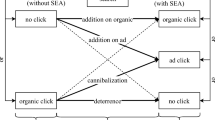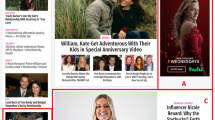Abstract
Search engine advertising has emerged as the predominant form of advertising on the Internet. Despite its increasing importance academic research on this topic is scarce. Several authors have called for more research on how the content of the ad influences its evaluation. This exploratory study builds on this call for more research and examines the impact of evidence type on click-through and conversion rates in a search engine advertising setting. We find that click-through rates are higher for advertisements involving expert evidence and statistical evidence than for advertisements involving causal evidence. On the contrary, we find that causal evidence results in higher conversion rates than other types of evidence. These findings help marketers to fine-tune their advertising in search engines. In particular, if their aim is to attract people to the website, expert evidence and statistical evidence should be used, while causal evidence works best if the main objective is to generate conversions.

Similar content being viewed by others
Notes
Results of the individual analyses are available upon request.
References
Agarwal, A., Hosanagar, K., & Smith, M. D. (2011). Location, location, location: An analysis of profitability of position in online advertisement markets. Journal of Marketing Research, 48(6), 1057–1073.
Bajaj, A., Hotchkiss, G. & Wood, C. (2006). Factors influencing the ‘search link click’ decision: An experiment. Proceedings of the Society for Marketing Advances.
Brody, A. (2002). A taxonomy of web search. SIGIR Forum, 36(2), 3–10.
Bucklin, R. E., & Sismeiro, C. (2009). Click here for Internet insight: Advances in clickstream data analysis in marketing. Journal of Interactive Marketing, 23(1), 35–48.
Doubleclick (2005). Search before the purchase: Understanding buyer search activity as it builds to online purchase. Available at www.doubleclick.com. Accessed 1 Feb 2013.
eConsultancy (2010). How we shop in 2010: Habits and motivations of US consumers. Available at http://econsultancy.com/uk/reports/habits-and-motivations-of-consumers. Accessed 1 Feb 2013.
Friedman, D. (2009). Conversion rates don’t vary much with ad position. Available at http://adwords.blogspot.com/ 2009/08/conversion-rates-dont-vary-much-with-ad.html. Accessed 1 Feb 2013.
Ghose, A., & Yang, S. (2009). An empirical analysis of search engine advertising: Sponsored search in electronic markets. Management Science, 55(10), 1605–1622.
Google AdWords Learning Center (2010). Google AdWords certification program help. Available at http://adwords.google.com/support/aw/bin/static.py?hl=en&page=examstudy.cs&rd=1. Accessed 1 Feb 2013.
Ha, L. (2008). Online advertising research in advertising journals: A review. Journal of Current Issues and Research in Advertising, 30(1), 31–48.
Hoeken, H., & Hustinx, L. (2003). The relative persuasiveness of anecdotal, statistical, causal, and expert evidence. In F. H. van Eemeren, J. A. Blair, C. A. Willard, & A. F. Snoeck Henkemans (Eds.), Proceedings of the Fifth Conference of the International Society for the Study of Argumentation (pp. 497–502). Amsterdam: Sic Sat.
Hoeken, H., & Hustinx, L. (2009). When is statistical evidence superior to anecdotal evidence in supporting probability claims? The role of argument type. Human Communication Research, 35(4), 491–510.
Hornikx, J. (2005). A review of experimental research on the relative persuasiveness of anecdotal, statistical, causal, and expert evidence. Studies in Communication Sciences, 5(1), 205–216.
Hornikx, J. (2008). Comparing the actual and expected persuasiveness of evidence types: How good are lay people at selecting persuasive evidence? Argumentation, 22(4), 555–569.
Hotchkiss, G., Garrison, M., & Jensen, S. (2004). Search engine usage in North America. Enquiro Search Solutions, 1–60.
Hotchkiss, G., Sherman, T., Tobin, R., Bates, C., & Brown, K. (2010). Search engine results: 2010. Enquiro Search Solutions, 1–61
Jansen, B. J. (2007). The comparative effectiveness of sponsored and non-sponsored links for Web E-commerce queries. ACM Transactions on the Web, 1(1), 1–25.
Jansen, B. J., & Resnick, M. (2006). An examination of searcher’s perceptions of nonsponsored and sponsored links during Ecommerce Web searching. Journal of the American Society for Information Science and Technology, 57(14), 1949–1961.
Jansen, B.J., & Spink, A. (2007). The effect on click-through of combining sponsored and non-sponsored search engine results in a single listing. Proceedings of the 2007 Workshop on Sponsored Search Actions.
Johnson, E. J., Moe, W. M., Fader, P. S., Bellman, S., & Lohse, G. L. (2004). On the depth and dynamics of online search behavior. Management Science, 50(3), 299–308.
Lomax, R. G. (2007). An introduction to statistical concepts for education and behavioral sciences (2nd ed.). Mahwah: Lawrence Erlbaum Associates.
Manrai, L. A., & Gardner, M. P. (1992). Consumer processing of social ideas advertising: A conceptual model. In J. F. Sherry Jr. & B. Sternthal (Eds.), Advances in consumer research volume (Vol. 19, pp. 15–22). Provo: Association for Consumer Research.
Marketingcharts (2012). Global display ad print growth forecast to outpace paid search. Available at www.marketingcharts.com . Accessed 1 Feb 2013.
Massi Lindsey, L. L., & Ah Yun, K. (2003). Examining the persuasive effect of statistical messages: A test of mediating relationships. Communication Studies, 54(3), 306–321.
Murphy, P. K., Long, J. F., Holleran, T. A., & Esterly, E. (2003). Persuasion online or on paper: A new take on an old issue. Learning and Instruction, 13(5), 511–532.
Park, H. S., Levine, T. R., Kingsley Westerman, C. Y., Orfgen, T., & Foregger, S. (2007). The effects of argument quality and involvement type on attitude formation and attitude change: A test of dual-process and social judgment predictions. Human Communication Research, 33(1), 81–102.
Peterson, R. A., & Merino, M. C. (2003). Consumer information search behavior and the Internet. Psychology and Marketing, 20(2), 99–121.
Petty, R. E., Cacioppo, J. T., & Schumann, D. (1983). Central and peripheral routes to advertising effectiveness: The moderating role of involvement. Journal of Consumer Research, 10(2), 135–146.
Reinard, J. C. (2006). Communication research statistics. Thousand Oaks: Sage Publications.
Reynolds, R. A., & Reynolds, J. L. (2002). Evidence. In J. P. Dillard & M. Pfau (Eds.), The persuasion handbook: Developments in theory and practice (pp. 427–444). Thousand Oaks: Sage.
Rieke, R., & Sillars, M. O. (1984). Argumentation and the decision making process. New York: Harper Collins.
Rutz, O. J., & Trusov, M. (2011). Zooming in on paid search ads—a consumer-level model calibrated on aggregated data. Marketing Science, 30(5), 789–800.
Rutz, O. J., Bucklin, R. E., & Sonnier, G. P. (2012). A latent instrumental variables approach to modeling keyword conversion in paid search advertising. Journal of Marketing Research, 49(3), 306–319.
Singh, S. N., & Dalal, N. P. (1999). Web home pages as advertisements. Communications of the ACM, 42(8), 91–98.
Slusher, M. P., & Anderson, C. A. (1996). Using causal persuasive arguments to change beliefs and teach new information: The mediating role of explanation availability and evaluation bias in the acceptance of knowledge. Journal of Educational Psychology, 88(1), 110–122.
Yang, S., & Ghose, A. (2010). Analyzing the relationship between organic and sponsored search advertising: Positive, negative, or zero interdependence? Marketing Science, 29(4), 602–623.
Yao, S., & Mela, C. F. (2011). A dynamic model of sponsored search advertising. Marketing Science, 30(3), 447–468.
Author information
Authors and Affiliations
Corresponding author
Rights and permissions
About this article
Cite this article
Haans, H., Raassens, N. & van Hout, R. Search engine advertisements: The impact of advertising statements on click-through and conversion rates. Mark Lett 24, 151–163 (2013). https://doi.org/10.1007/s11002-013-9226-5
Published:
Issue Date:
DOI: https://doi.org/10.1007/s11002-013-9226-5




